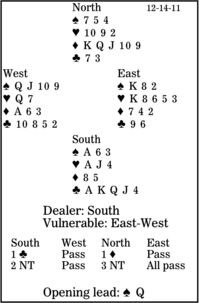Bridge column, December 14: A count card counts rarely on defense

The count signal doesn't occur often at the bridge table, especially below the expert ranks. Yes, a high-low (an echo) to show a doubleton when you hope to trump the third round of the suit occurs from time to time. However, there is one time you must give a count signal, playing your lowest with an odd number of cards in the suit, or starting an echo with an even number. This deal is a textbook example.
South is in three no-trump. West leads the spade queen. How should the play proceed?
South's rebid shows 18, 19 or a so-so 20 points, and is in principle game-forcing. (Yes, South might have opened two no-trump.)
At trick one, East must play his eight, the high card being an attitude signal saying that he has the king. South will probably duck. Then West should continue with the spade nine, the bottom of his sequence. East will overtake with his king and return the suit.
South has seven winners: one spade, one heart and five clubs. He needs to get two diamonds.
South does best to lead a diamond at trick four, not tell the defenders that he has five club tricks. Since South has at least two diamonds, West ducks and notes his partner's two. Since this must be East's lowest, it shows an odd number of diamonds, which West assumes is three. He wins the second diamond with his ace (when declarer is playing his last card in the suit), cashes his spade winner, and exits with a heart or a club. Now the contract must go down one.
** ** **
COPYRIGHT 2011, UNITED FEATURE SYNDICATE
DISTRIBUTED BY UNIVERSAL UCLICK FOR UFS

